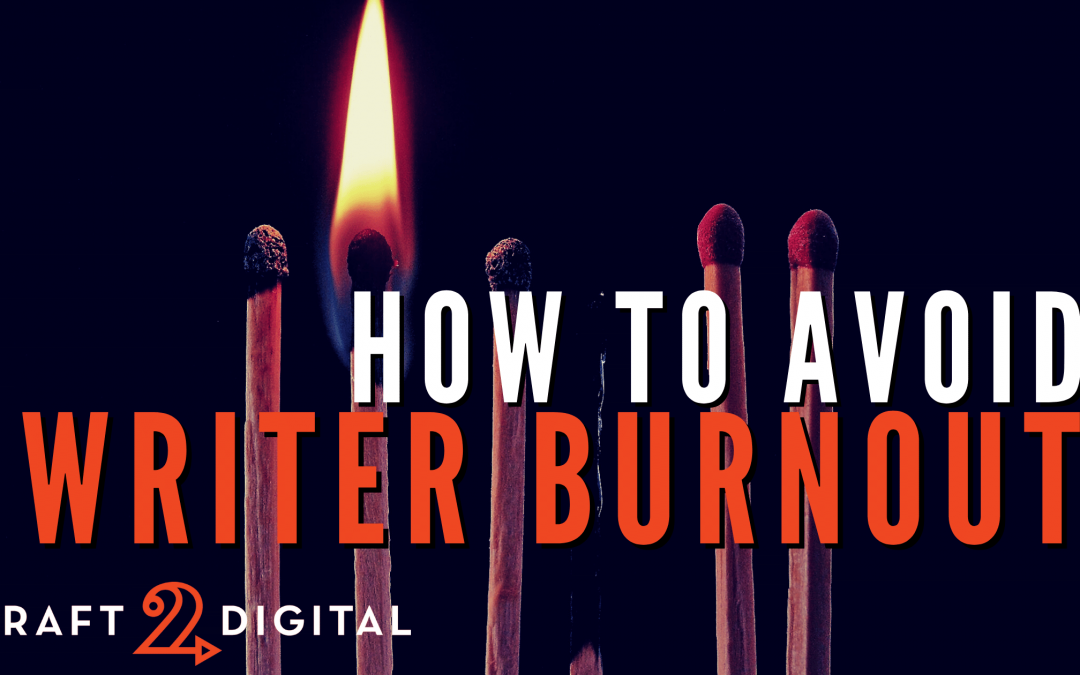Let’s be honest—the pandemic didn’t change the habits of most full-time (or even part-time) writers all that much. We’re no strangers to spending hours locked in our homes, typing away at a computer. For many of us, WFH wasn’t a life change at all. But all that hunching over a keyboard and focusing hard on your novel will eventually have a major side-effect if you aren’t careful: writer burnout.
And you don’t have to be a full-time writer to experience burnout, either. Knowledge workers across industries run into the same issues, especially if they’re juggling creative tasks for paid and unpaid work.
The symptoms of burnout vary depending on who you are and how you cope with stress. But the list usually looks something like this:
- Lack of motivation
- Exhaustion
- Poor memory
- Failing health
- Isolation
- Hours of unproductive work
- And, of course, that old classic—writer’s block
Catch burnout before it sets in, and you have a much better shot at avoiding the worst of it. You might even experience that elusive state known as “work-life balance.”
To that end, here are a few tips to help keep you balanced, motivated, and fresh as a daisy—creatively speaking.
Move your body
Sometimes the best way to get more productive is to stand up and get out of your writer’s chair.
That might sound counterintuitive, but some of our favorite authors swear by the mind-body connection. Too much emphasis on sitting and writing is bad for the creative mind, it seems.
Christian Brown told us that he believes “the connection between body and mind, especially as a creative person, is so important.” Developing his willpower through exercise—the ability to show up, focus on a task, and then be finished—has helped him grow as a writer.
Our very own Mark Leslie Lefevbre said something similar. “I find the mind-body connection really, really valuable. Going for a run, going for a walk, occupying a different part of my body so that my mind can be free.”
This doesn’t have to mean anything strenuous, either. A simple walk outside will get your blood flowing and help your brain shift gears for a bit. And if you get inspired while you’re out and about, you can always write by dictation.
Schedule your day in blocks
Mary Robinette Kowal wears so many different hats that she sometimes seems more like a professional plate-spinner than anything else. When we asked her how she does it, she said, “I keep a very tightly focused spotlight so no one can see the shattered crockery at my feet.”
So Mary knows a thing or two about burnout—and the practice that’s kept her sane is maintaining a balanced calendar.
First, she spent the time to consider which activities make her happiest. Those were things like “craftsmanship,” “impact,” and “sharing.” When she thought intentionally about these groupings, she realized that all of her time was dedicated to “impact,” with almost no time for anything else.
Now that she knows what brings her joy and changes her energy for the better, she sets aside blocks of time on her calendar each day to work for each category. This way, even on her busiest days, she’s still setting aside time to do the things that replenish her energy—not just things that deplete it, saving her from potential burnout.
We know you love to write and do other creative work, but you probably love a few other things, too. So schedule blocks of time in your day for other activities. Even if it’s just 15-20 minute pockets of time when you can walk the dog, play with your kids, or (gasp) read a book for pleasure.
The writing will still be there when you get back, and you’ll be that much happier for it.
Rest
According to Alex Pang’s research, most people have the capacity to do great creative work for about four hours per day. After that, the quality of our work declines sharply.
Sure, you can work longer than that. But plugging away at the same task for hours on end has been shown to deliver worse results than scheduling shorter working blocks followed by periods of rest.
Of course, you might only have 30 spare minutes per day to write, and you can’t always choose your state of mind when those 30 minutes arise. But it’s worth experimenting to see if the “rest” strategy will work for you.
If you can, arrange your work to fall into shorter blocks with periods of rest in between, yielding more productivity and less chance of burnout. You might find that you’re able to accomplish eight hours of work in just four hours of time, if you’re approaching that work well-rested and in a focused state.
Don’t compare
Finally, don’t compare your output to other authors or try to keep up with their pace. Sure, some authors are writing a book a month. Others take years to finish even a short story. Your pace will be yours alone, so don’t spin your wheels trying to keep up with the Joneses (or the Tumlinsons).
That doesn’t mean you shouldn’t push yourself—but use your own comfort zone as a guide, instead of someone else’s.
Have a tip for avoiding writer burnout that we didn’t include here? Let us know in the comments!
